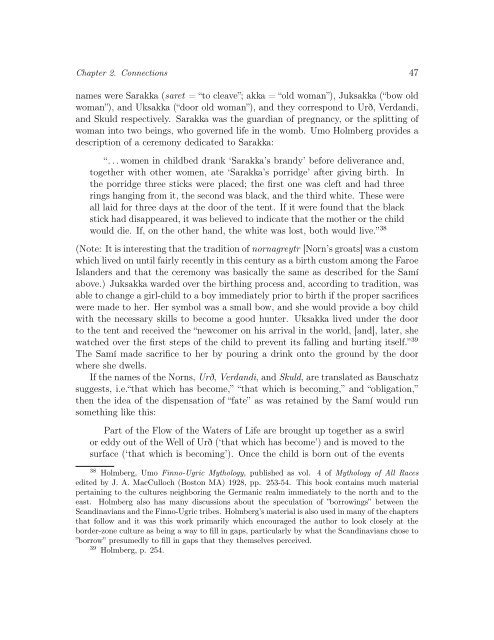Untitled - Awaken Video
Untitled - Awaken Video
Untitled - Awaken Video
Create successful ePaper yourself
Turn your PDF publications into a flip-book with our unique Google optimized e-Paper software.
Chapter 2. Connections 47<br />
names were Sarakka (saret = “to cleave”; akka = “old woman”), Juksakka (“bow old<br />
woman”), and Uksakka (“door old woman”), and they correspond to Urð, Verdandi,<br />
and Skuld respectively. Sarakka was the guardian of pregnancy, or the splitting of<br />
woman into two beings, who governed life in the womb. Umo Holmberg provides a<br />
description of a ceremony dedicated to Sarakka:<br />
“. . . women in childbed drank ‘Sarakka’s brandy’ before deliverance and,<br />
together with other women, ate ‘Sarakka’s porridge’ after giving birth. In<br />
the porridge three sticks were placed; the first one was cleft and had three<br />
rings hanging from it, the second was black, and the third white. These were<br />
all laid for three days at the door of the tent. If it were found that the black<br />
stick had disappeared, it was believed to indicate that the mother or the child<br />
would die. If, on the other hand, the white was lost, both would live.” 38<br />
(Note: It is interesting that the tradition of nornagreytr [Norn’s groats] was a custom<br />
which lived on until fairly recently in this century as a birth custom among the Faroe<br />
Islanders and that the ceremony was basically the same as described for the Samí<br />
above.) Juksakka warded over the birthing process and, according to tradition, was<br />
able to change a girl-child to a boy immediately prior to birth if the proper sacrifices<br />
were made to her. Her symbol was a small bow, and she would provide a boy child<br />
with the necessary skills to become a good hunter. Uksakka lived under the door<br />
to the tent and received the “newcomer on his arrival in the world, [and], later, she<br />
watched over the first steps of the child to prevent its falling and hurting itself.” 39<br />
The Samí made sacrifice to her by pouring a drink onto the ground by the door<br />
where she dwells.<br />
If the names of the Norns, Urð, Verdandi, and Skuld, are translated as Bauschatz<br />
suggests, i.e.“that which has become,” “that which is becoming,” and “obligation,”<br />
then the idea of the dispensation of “fate” as was retained by the Samí would run<br />
something like this:<br />
Part of the Flow of the Waters of Life are brought up together as a swirl<br />
or eddy out of the Well of Urð (‘that which has become’) and is moved to the<br />
surface (‘that which is becoming’). Once the child is born out of the events<br />
38 Holmberg, Umo Finno-Ugric Mythology, published as vol. 4 of Mythology of All Races<br />
edited by J. A. MacCulloch (Boston MA) 1928, pp. 253-54. This book contains much material<br />
pertaining to the cultures neighboring the Germanic realm immediately to the north and to the<br />
east. Holmberg also has many discussions about the speculation of ”borrowings” between the<br />
Scandinavians and the Finno-Ugric tribes. Holmberg’s material is also used in many of the chapters<br />
that follow and it was this work primarily which encouraged the author to look closely at the<br />
border-zone culture as being a way to fill in gaps, particularly by what the Scandinavians chose to<br />
”borrow” presumedly to fill in gaps that they themselves perceived.<br />
39 Holmberg, p. 254.
















